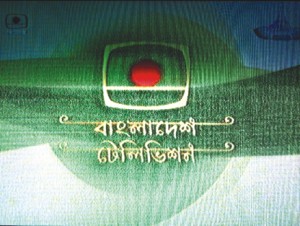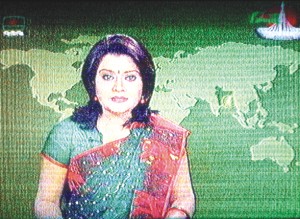| Media
BTV A Lost Cause?
Farhana Urmee
 Evenings in the Dhaka city-crowded, noisy, flashing colourful lights- was very different in the late '80s or early '90s. People usually rushed home before nightfall, roads and markets were deserted. Reaching home people managed to have their chores done as quickly as possible. They were all getting ready to get glued to the television screen that aired the one and only channel. Weekly Moner Mukurey on Thursday or drama serial on Tuesday was extremely popular among the Bangladesh Television (BTV) watchers. Evenings in the Dhaka city-crowded, noisy, flashing colourful lights- was very different in the late '80s or early '90s. People usually rushed home before nightfall, roads and markets were deserted. Reaching home people managed to have their chores done as quickly as possible. They were all getting ready to get glued to the television screen that aired the one and only channel. Weekly Moner Mukurey on Thursday or drama serial on Tuesday was extremely popular among the Bangladesh Television (BTV) watchers.
People bringing out processions and attacking a writer's residence for having a sad ending of the central character of the drama serial Kothau Keu Nei (telecasted in 1993, on BTV) was proof of just how much BTV could reach out to the people.
The state-run TV channel BTV has long lost its former glory with a fast dwindling audience. People having other options of entertainment hardly switch to BTV. Ramzan Ali, a mufassil dweller says that he hardly watches BTV programmes. “Some time due to load-shedding when our cable connection fails, and having no other way out we have to watch BTV; the purpose is not entertainment, but rather, to pass time,” says Ramzan.
City dweller Mostafa on the other hand gives his reason for not watching the national channel. “BTV is getting boring day by day. All the other TV channels are going forward but in the case of our national television it is going backward”, says Mostafa, a regular TV viewer, adding that all sorts of nepotism, politicisation is visible on the screen and we get to see the same faces for five years. With the shifting of power even the enlisted artistes of BTV are changed. Such practice triggered by politics often deprives us (the regular audience) and compels us to avoid BTV.”
 BTV could not hold its original viewers least of all create a new generation of viewers. BTV's masterpiece programmes are just in the memory of people. But why has BTV lost its grandeur? The reason behind exploring media is definitely entertainment, and to get information. BTV's history says, regarding entertaining programme BTV once used to telecast well-written drama serials, magazine programme with a healthy sense of humour and extremely popular foreign programmes. BTV could not hold its original viewers least of all create a new generation of viewers. BTV's masterpiece programmes are just in the memory of people. But why has BTV lost its grandeur? The reason behind exploring media is definitely entertainment, and to get information. BTV's history says, regarding entertaining programme BTV once used to telecast well-written drama serials, magazine programme with a healthy sense of humour and extremely popular foreign programmes.
According to BTV's own study in 1989, BTV 54.2 percent of its programmes were entertainment-based. That included drama serials, magazine programme, sports, musical and dancing shows and imported foreign programmes.
Studies have shown that after the introduction of cable TV in the country, the total time that people spend watching television has increased especially among the urban audience. But nowadays TV viewers spend most of their time watching foreign channels or local private satellite channels. Researchers have also marked the year 1993 as the time for BTV losing its popularity, as it was the beginning of open sky culture in the country. Media experts have explained this trend more widely. Although BTV has to compete with commercially driven and technically rich programmes of private TV channels, there are other factors are active to exclude BTV from competition.
BTV insiders say, “it is known that BTV often lacks modern technical support for quality programme making, yet, the reasons behind BTV's becoming a non-starter is not confined only to the issue of lack of technical equipment. In early times there was a good blend of programme making, intellect and hard work, which delivered high-quality programmes. For example, the musical programme Upohar, performed by Runa Laila did not get that much high quality technical support, yet it was a very successful and memorable one. Nowadays, programme producers also, believe in short-cut methods of making programmes, and do not take their job seriously which hinders their excellence to show up in their work.”
From its inception as Pakistan Television Dacca in 1964 BTV has lived through different phases of time. It has seen a number of changes in broadcasting history of Bangladesh. For the first ten years BTV's transmission time was only three hours a day. The daily transmission time was raised to four hours in 1975, five and half hours in 1976-78 and six hours in 1979. In early '80s more time was added to its daily transmission schedule. And twenty first century made BTV to experience stepping to satellite transmission and to be watched world wide 24/7.
 |
BTV programmes and news. |
Md Barkat Ullah former General Manager, Bangladesh Television says, “State-run BTV has always been used as the government's mouthpiece in information dissemination. The situation gets worse when politics dominates even in the selection of artistes and producers in entertainment based programmes.” Barkat who worked for a private TV channel as well says that the decision makers in BTV should be free in taking decisions to run the television without any pressure from the information ministry. “Autonomy is necessary to run the television as BTV is still the one that reaches 90 percent of the population due to its terrestrial facility,” observes Barkat.
The functional and financial autonomy of an organisation make it to meet contemporary demand and to keep going with competition. If programme producers assume that they are doing jobs with no accountability, the craving for something innovative and artistic to be done will be missing among them, continues Barkat.
“The major political parties which have been ruling the country alternately since 1991 are not letting BTV be autonomous and stand as a professional TV channel. BTV has to be professional in every aspect; like, a programme producer should be competent for his job along with getting the facility to be well trained to conduct his responsibility. Again, recruitment process should be continued smoothly in BTV to welcome new hands,” adds Barkat.
If BTV continues to be a propaganda tool for respective governments with a declining number of viewers the potential of public television as a tool for social awareness, national unity and entertainment for the general people, will be lost. That indeed would be a tragedy.
Copyright
(R) thedailystar.net 2010 |
